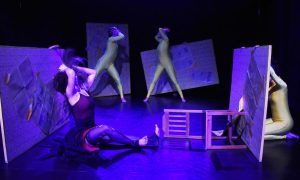In an effort to boost self-branding, build a professional network or to simply stay informed, many young dancers continue to invade social media platforms, particularly Instagram, by setting up profiles. While social media can be a gift in many ways and can truly be wielded as a positive tool when managed correctly, it is also proving to be a threat to a myriad of young dancers.
Sometimes the threat is manifested by dancers being influenced to push themselves beyond healthy, necessary boundaries – like with focuses on extreme flexibility or unrealistic body expectations. Other times it’s cyberbullying. Often, the influences of hyper-sexualization can inspire young girls and boys to post provocative content for the attention it brings.
With all of these negative results of social media in mind, Dance Informa asks: Is it safe to create a dance social media profile? Particularly for young student dancers?
Continuing our new series seeking to address some of the harder questions affecting the dance industry, Dance Informa now takes a look at this issue with the help of representatives from dance educator Leslie Scott’s non-profit organization Youth Protection Advocates in Dance (YPAD). First, let’s look at YPAD’s evidence-based research on this subject.
Considering Dance-Specific Research
Under the expert guidance of Dr. Tomi-Ann Roberts, PhD, the chair of Colorado College’s Psychology Department, YPAD surveyed 312 dancers aged 12-17 from 2013-2015, specifically on the topic of their social media usage. The non-profit’s results were telling.
When asked which pictures and videos received the most attention on their social media accounts, the top four answers were “sexy”, “duck lips/trout pouts”, “pics/videos with famous choreographers” and “acro dance/tricks”.
When questioned how social media affects their body image, the students’ top answers were: “I am more self-conscious about my body, talent and fashion”; “I find myself comparing my ‘look’ and body to others more”; “I notice more flaws on my face”; and “I have started skipping meals and dieting.”
In addition, 92 percent reported having witnessed dance-related cyberbullying based on the definition from stopcyberbullying.org. They had seen others put down another dancer’s talent, make up false rumors, and post negative comments about a dancer’s physical appearance (body, weight or face) and other personal facets (faith, ethnicity and sexual orientation).
More than two-thirds of these students said they had seen something online that scared them, and when asked if they reported it to an adult, 54 percent said no.
One 12-year-old female said, “I feel a lot of pressure to be hot and skinny. I do compare my body to celebrity dancers online.”
From A Body Image Specialist’s Perspective
YPAD Certification Contributor Dawn Smith Theodore is a former studio owner of 25 years and an eating disorder and body image certified therapist. Author of the book Tutu Thin, she outlines many reasons why social media can be dangerous for young dancers – echoing the research.
Listing the reasons, she says it will cause them to begin comparing their dance abilities and physical bodies to others online at a young age and often leads them to feel self-conscious if they believe they don’t measure up.
She says that young dancers can be more provocative in their dancing because of what they see online, and that they often become overly concerned about how many likes or friends they have on social media. Moreover, Theodore points out that dancers may be trying dance moves promoted on social media that are too advanced for their age or ability, leading to injury.
To the young dancer who already has an account, Theodore advises, “Be sure to be positive in what you post about yourself and others. Energy follows thought, so spread positive images and words. You want to set an example so that others will look up to you.”
She highly recommends that all young dancers have parental guidance for their social media accounts so that “the page remains positive”.
She comments, “Social media allows people to present a life that is sometimes not real. Keep it real, and present the life you are actually living.”
From A Mediation Attorney and Dance Advocate’s Perspective
YPAD Advisory Panel Member and Certification Contributor Lisa Phelps is a mediation attorney and dance advocate based in Santa Barbara, CA. Holding degrees from Vanderbilt University’s Law School, the Paul Valéry University of Montpellier in France, and the University of California at Berkeley, she has over 15 years’ experience in labor and employment law. In the dance industry, she’s well known for her website and allied social media presence, SB Dance Sugar, which advocates for accessible, affordable dance for everyone.
For YPAD, Phelps teaches on social media safety, as well as sexual abuse and exploitation, which can often go hand in hand. She helps others weigh both the positives and negatives of using and sharing on social media.
For dance parents, she advises, “When a child or teen is ready to have a social media account, it can be helpful to create a social media ‘contract’ with them about permissible online behavior, including the types of content they can post, who they can ‘friend’ and follow, and how they can interact with others, what the expectations are for privacy settings, et cetera. For dancers, this contract should address how images or video of themselves dancing (as well as other posts) should be shared in order to reduce the potential negative effects on their developing self-esteem, as well as the risks of online bullying, exploitation and online sexual predators.”
On why this is important, she stresses, “Children and teens aren’t like adults. In terms of brain development, they are undergoing a period of tremendous neural plasticity. We now know that an adolescent’s experiences will mold and shape their still-forming brains and their lives forever, and this includes their experiences on social media. We are just starting to understand the potential impact of social media on teens, but a recent study from UCLA’s Ahmanson–Lovelace Brain Mapping Center found that when teens viewed their own photos obtaining a large number of likes on social media, it affected their brain’s frontal cortex, stimulating the same areas of the brain that drugs like heroin and cocaine do.”
She continues, “When we apply this to the dance context, we can see the potential risks of having a child or teen post dance photos of himself or herself online and getting likes (or not getting them), and how this could impact their self-esteem.”
Two particular areas of concern for her are the posting of videos containing sexualized dancing or “sexualized selfies” and young dancers posting content of themselves engaging in “extreme stretching or doing dangerous stunts”.
Phelps firmly states, “If we see that they are predominantly looking for approval or attention in an unhealthy way with a dance-related post instead of trying to connect with others, it’s time to intervene.”
When it comes to sexual exploitation and child sexual predators, she points out that, according to the FBI, there are approximately 750,000 child sexual predators online every day.
She warns, “Any child, anywhere can be a target. However, child-centered activities like sports or dance are places that predators target, and activities that involve children in tight-fitting clothing (gymnastics, dance, swimming) are even more attractive to them.”
Phelps shares that online predatory activity is on the rise, recalling statistics from The National Center for Missing and Exploited Children’s CyberTipline that reported receiving 8.2 million reports in 2016 alone. Twenty percent (one in five) of U.S. teenagers say they have received an unwanted online sexual solicitation, and 75 percent said they did not tell a parent.
Regarding the center’s data, Phelps says, “Parents and dance professionals can put this in perspective when looking at a typical junior high classroom, or at a group of 30-plus teen dancers at the studio: Six of the dancers have received an unwanted online sexual solicitation (and four to five of them have not told a parent), eight of them have been exposed to unwanted pornographic material, and one of them has received an aggressive sexual solicitation.”
Clearly passionate about the subject, Phelps shares many other disturbing trends. She also clarifies, however, that child sexual predators are 100 percent responsible for their actions and that dancers shouldn’t be scared away from sharing appropriate, positive content.
She concludes, “Just as we need to be mindful of our surroundings and potential risks in the real world, we need to be aware of the risks online and act accordingly. We don’t take candy from strangers, walk alone in high-crime areas at night, and we avoid certain beaches known for shark attacks. We need to guide our children and teens with the same vigilance online.”
From A Media Producer’s Perspective
YPAD Advisory Panel Member Jen Ray is the creator of Dancinema Productions, a company actively creating positive youth dance content for social media and in-person presentations. Ray’s company curates and screens dance films in the U.S. and Canada that celebrate healthy, age-appropriate media featuring young people.
On social media safety, she avidly echoes much of the same advice of Phelps and Theodore. She adds some crucial points, too. For one, parents should consider scheduling their kids’ social media time.
She says, “It is so easy to spend five, six, seven, eight, even more hours on there each day. If you honestly evaluate what is being consumed, the purpose and how else that time could be used, I bet you will usually find less time on there is beneficial.”
Then she expands the circle of responsibility for young dancers’ social media usage. “Teachers, choreographers, anyone who works with children must accept the responsibility that comes with it,” she says. “This means having knowledge of your privacy settings and awareness of exactly who is seeing what you share online. It will never hurt you to choose to be a positive example.”
Ray explains that really “every action and expression, online or in life, should come from an honest mind, and with purposeful intent.” For young dancers and everyone else engaging in social media, Ray invites them to ask the following questions for every post or online interaction:
– What is my intent?
– How might this help someone?
– How might this hurt someone?
– How could I communicate this message in person?
– What in the “real world” could I experience to achieve this desired result/feeling?
– How would things be different if I did not post this?
Ray concludes with this piece of advice: “Try saying your post out loud, even to another person or in a mirror. Does is sound/feel like the best version of yourself?”
If You or Your Child Need Help With Social Media
The reality is many youth and adults today struggle with their social media interactions. To respond to this, YPAD Founder Leslie Scott and Dr. Roberts run YPAD 3-Day Mindful Social Media Fasts. Scott says she started offering these to fill the need for training and awareness on how to engage with social media in a healthy way.
“I was receiving a lot of shares from teachers, studio owners, parents and youth regarding the strife social media was causing in their lives,” Scott says. “This unfortunately made sense since research proves that screen usage can have the same effect on the brain as a drug and can cause anxiety, depression and aggression. I wanted to give youth an opportunity to experience life for three days looking up and out in the world.”
She continues, “The reason the fast works is it allows youth to come to their own conclusions about how media is affecting their emotions, body image, judgments, self-esteem and relationships. The interactive shares I get to witness as the group goes through this together is powerful. When they return to social media, they can make more empowering choices for themselves through the awareness that has been gained.”
Through Dr. Roberts’ work with the participants of these fasts, YPAD was able to produce the world’s first research study on how social media is impacting youth in dance, providing the statistics referenced earlier.
Dr. Roberts noted that after fasting, students tend to have significant improvements in the areas of “self-esteem, self-objectification (seeing your body from an outsider’s view, body shame, et cetera) and self-compassion.”
For more information on YPAD or these fasts, visit www.ypad4change.org/socialmedia.
If you need to report a suspected internet-related abuse and/or crime to law enforcement agencies, here are two resources:
The CyberTipline: Operated by the National Center for Missing and Exploited Children, this is a federally funded online reporting center for crimes involving child pornography, child sexual molestation and online enticement of children for sexual acts. Reports are investigated and forwarded to appropriate law enforcement agencies.
Internet Crimes Against Children (ICAC) Task Forces: Funded by the federal government and covering most U.S. jurisdictions, this force provides resources for investigating digital crimes involving child sexual exploitation.
By Chelsea Thomas of Dance Informa.















